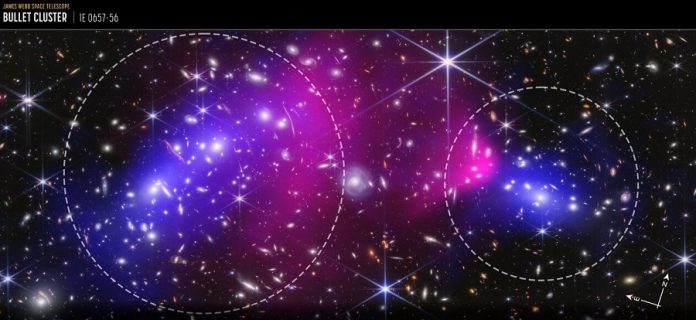
NASA’s James Webb Space Telescope has taken a closer look at the famous Bullet Cluster—a giant space collision between two galaxy clusters—and revealed new insights about one of the universe’s greatest mysteries: dark matter.
Located 3.8 billion light-years away in the Carina constellation, the Bullet Cluster is made of two enormous groups of galaxies that crashed into each other billions of years ago.
When galaxies collide like this, they don’t just create a cosmic mess—they give scientists a chance to study invisible things, like dark matter, by watching how light is bent as it travels through the chaos.
This bending of light, known as gravitational lensing, helps astronomers figure out how mass is spread out across space.
Using Webb’s powerful near-infrared camera, researchers captured incredibly sharp and deep images of the Bullet Cluster.
These images show more distant and faint galaxies than ever before. But more importantly, they gave scientists the best view yet of how much mass—both visible and invisible—is inside the cluster.
By carefully measuring how the light from thousands of background galaxies is distorted, the team created a much more detailed map of the Bullet Cluster’s mass.
This includes both regular matter—like stars, gas, and dust—and dark matter, which doesn’t give off any light. Previous studies used less detailed data, but Webb’s observations provide the largest and most precise lensing dataset of the cluster so far.
One of the key discoveries from this new research is that intracluster stars—the stars that float freely between galaxies—appear to follow the distribution of dark matter.
This means they might be good indicators of where dark matter is located. The researchers also confirmed that even in such a violent, dynamic system, the dark matter stayed in place with the galaxies instead of being pushed around like the hot gas was during the collision.
To visualize this, the scientists compared it to looking at pebbles at the bottom of a pond. You can’t see the water itself, but if wind causes ripples, those ripples distort the view of the pebbles. In this case, the water represents dark matter and the pebbles are background galaxies.
A new image released by NASA combines Webb’s infrared view with data from the Chandra X-ray Observatory.
The pink areas show superhot gas left behind during the collision, while blue areas show where dark matter is.
Webb’s detailed measurements show that the galaxies and dark matter remained together, while the gas was separated and dragged behind—giving more support to the idea that dark matter barely interacts with itself or anything else.
Interestingly, the team also noticed that the larger galaxy cluster on the left side of the Bullet Cluster may have been involved in more than one collision. Its lopsided shape suggests a more complicated past than previously thought, with signs of multiple smash-ups billions of years ago.
Even though Webb gave scientists a detailed view of part of the cluster—what one astronomer described as “the head of a giant”—there’s still more to explore.
Future observations from NASA’s upcoming Nancy Grace Roman Space Telescope, set to launch by 2027, will help complete the picture by imaging the rest of this cosmic “giant.” With that data, scientists hope to fully reconstruct the massive collision on computers and unlock even more secrets about the mysterious dark matter that makes up much of our universe.
Source: NASA.



